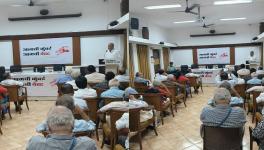Bank Privatisation: The Final Push?

THAT the large non-performing assets (NPAs) on the books of banks, especially public sector banks, is the only blemish in India’s continuing economic story, is the official view. Speaking recently at the Council on Foreign Relations in New York, Finance Minister Arun Jaitley reportedly declared that NPAs were “one very big challenge” facing the government, and resolving that problem was its “top priority”. Parallel to this, others such as top-level Reserve Bank of India officials, have been floating trial balloons, in the form of recommendations on various methods of addressing the NPAs. Not the least controversial among these suggestions is one, which calls for the sale of equity and assets by public sector banks, which will shrink their size and reduce government shareholding to well below 50 percent. NPAs are providing the final push for re-privatisation of banking. But opting for this may amount to throwing the baby out with the bathwater.
It cannot be denied that NPAs on the books of India’s banks have been rising rapidly in recent times, and provision for loss assets is affecting profitability extremely adversely. The ratio of gross non-performing assets to total advances rose from 5.1 percent at the end of March 2015 to 7.8 percent at the end of March 2016 and 9.1 percent at the end of September 2016. The figure is expected to exceed 10 percent by March 2018.
This sharp increase in GNPAs during the tenure of the current government is the result of two factors. First, the decision of the Reserve Bank of India to put to an end the practice of restructuring non-performing loans and treat the resulting ‘restructured’ assets as standard assets. And, second the unwillingness of the government to set aside adequate funds to write off the bad loans of the public sector banks, which were the principal locations for bad assets. GNPAs with the public sector banks stood at Rs 5.02 lakh crore at the end of March 2016, but the budgetary support for recapitalisation during 2015-16 and 2016-17 amounts to a tenth of that sum or Rs 50,000 crore.
This reticence to recapitalise adequately was a signal that the government would not relax its fiscal conservatism to release resources to restructure the public sector banks, leaving them finally to their own devices. This does not meet the criterion of fairness, since what was happening to the public sector banks was, in substantial measure, the result of other policies being adopted by the government. Two such policies need special mention. One was the decision to substantially relax a range of controls on foreign capital inflow into the economy, through moves first adopted in the early 1990s, that gained momentum subsequently. This resulted, during the post-2003 surge of cross-border capital flows worldwide, in a huge infusion of external liquidity into India that was nowhere near matched by foreign exchange outflows either for current expenditure or investments abroad. The increase in liquidity swelled deposits with the banks and forced a sharp increase in the credit advanced by the banking system. As the Reserve Bank of India (RBI) has itself recognised, the rapid build up of credit resulting from the expansion in deposits provided the ground for inadequately informed or risky lending decisions.
The second set of policies that underlie the bad debt problem was the decision to encourage private players into the infrastructural areas and incentivise investment by them, to make up for shortfalls in public investment as a result of the fiscal ‘crunch’. Simultaneously the government in the name of financial reform shut down the development banks with access to lower cost capital because of lending and guarantee support from the central banks and the government. Development banks were too dependent on the State and prevented the provision of a level playing field for the private sector, it was argued. So the promoters of many infrastructural projects, deprived of access to development banks, had to turn to the commercial banks for financing. Possibly mistaken that these projects had an unstated government guarantee of viability, the banks flush with funds came forward with the funding. Unfortunately, many of these projects proved unviable, and soon were defaulting on their debt service commitments, contributing in substantial measure to the NPA problem. So the government’s policy of private sector based infrastructural development, combined with its decision to close development banks, led to increased bank exposure to risky infrastructural projects with long gestation lags.
The effect of all this has been a now forgotten feature of post-liberalisation banking in India. That effect was a post 2003 credit surge. That surge increased exposure to more risky sectors and borrowers and resulted in a reversal of the decline in the Gross NPA ratio ensured by a restructuring exercise that began in the mid 1990s. GNPAs had come down from 15.7 percent of gross advances in 1996-97 to 10.4 percent in 2001-02, 5.2 percent in 2004-05and 2.3 percent in 2008-09. It is in the period since then that the ratio has again risen back to an estimated 10 percent plus currently. In sum, the years of liberalisation and reform have been characterised by a decline, followed by a rapid build up in the NPA ratio. Hence addressing the phenomenon required the State to rethink the policies that led to the explosive NPA turn-around.
Those policies led to an unsustainable expansion in commercial bank credit to finance the private consumption and investment that drove the economy’s high growth. With the credit boom running up against large scale default, that growth is under question. The Reserve Bank of India’s Financial Stability Report released in December 2016 recognised this strain when it said that NPAs together with the danger that deteriorating macroeconomic conditions could worsen the problems faced by these banks, had made the banks “risk averse”, as they focused on “cleaning up their balance sheets”. Outstanding non-food credit from the SCBs, which rose in all other major areas such as agriculture, services and personal loans, fell in the industry sector over the year ending November 2016. Outstanding loans to industry which had risen from Rs 25,419 billion on November 28, 2014 to Rs 26,687 billion on November 27, 2015, fell to Rs 25,793 billion on November 25, 2016.
The decline in lending to industry was focused on the infrastructural sector, with power and telecommunications setting the trend. Outstanding loans to power, which had risen from Rs 5,311 billion in end November 2014 to Rs 5,865 billion at the end of November 2015, fell significantly to Rs 5,253 billion at the end of November 2016. The figures for telecommunications were Rs 863 billion, Rs 907 billion and Rs 849 billion respectively on those three dates.
If despite this, non-food credit growth was positive during 2015-16 (November to November), though reflecting considerable deceleration in growth relative to the previous year, it was largely because of a sharp increase in retail lending, mainly for housing investments and vehicle purchases. Even in financial year 2015-16, retail lending registered double digit growth with housing loans that accounted for 54 percent of the total, increasing by more than 16 percent. Outstanding housing loans also rose from Rs 5,946 billion on November 28, 2014 to Rs 7,052 billion on November 27, 2015, and to Rs 8,153 billion on November 25, 2016. The corresponding figures for vehicle loans were Rs 1,194 billion, Rs 1,379 billion and Rs 1,673 billion respectively.
Thus, clearly, banks are cutting down on their overall lending and restructuring their portfolios to reduce exposure to the infrastructure sector in favour of the retail sector. Both these trends have implications for growth in the immediate future. For a decade and a half now, Indian growth has been fuelled by credit financed investment and consumption spending. So a deceleration in credit expansion implies that the principal stimulus to growth is being dampened, with obvious implications.
So resolving the NPA issue is crucial to keep credit flowing and sustaining growth. Moreover, restructuring debt is also the means to preventing a deleveraging process that could convert a growth slowdown into a crisis. Yet, trapped in its obsession with the fiscal deficit and unwilling to raise additional revenues through taxation, the government is hoping that the banks that were called upon to take on the task of driving growth would address the resulting NPA problem themselves.
Policies have been aimed at supporting the restructuring efforts of the banks. One was to permit private Asset Reconstruction Corporations, which would buy up stressed or loss assets at a large discount, with part payment in cash and the rest in security receipts that would be settled when the loan assets had been restructured and sold. Despite the presence of 16 ARCs by 2016, the pace of acquisition of NPAs by these companies has been slow, because of the huge discounts they demand and their own limited absorption capacities. Faced with this impasse the government has at various points considered the option of setting up a State-backed ARC. But that would require outlays from the budget, with attendant implications for budgetary outlays and the fiscal deficit it is unwilling to accept.
To avoid this, the government seems to be making a final push for privatisation, so as to mobilise resources for this round of NPA write off. That would let off the defaulters, often wilful, who have taken large loans and misused them. But it would also shrink the public sector and place the private sector in charge of much of credit flow in the economy. The private banking sector will cherry pick its clients and finance high-return speculative ventures, depriving industry and infrastructure of financial support. Growth would suffer. Many would be excluded from financial access. And if global experience is evidence, NPAs would only return. But an obsession with fiscal conservatism promoted by finance is pushing the government to adopt this drastic and counterproductive turn in policy.
Disclaimer: The views expressed here are the author's personal views, and do not necessarily represent the views of Newsclick.
Get the latest reports & analysis with people's perspective on Protests, movements & deep analytical videos, discussions of the current affairs in your Telegram app. Subscribe to NewsClick's Telegram channel & get Real-Time updates on stories, as they get published on our website.
























